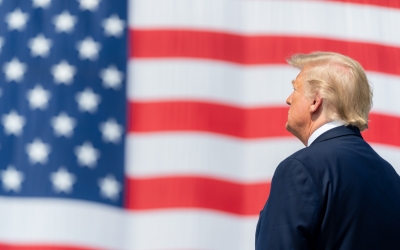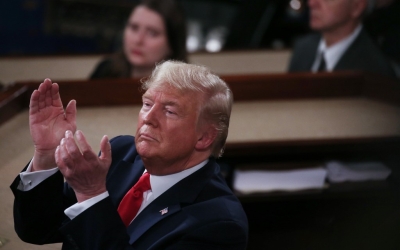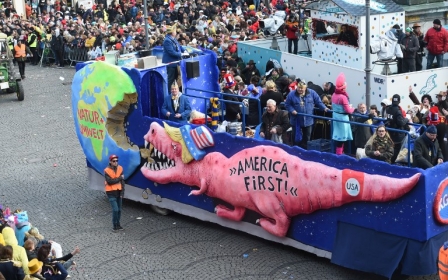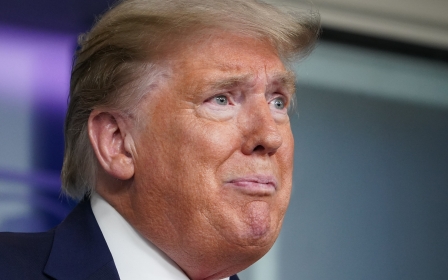Liberalism is the human face of white supremacy
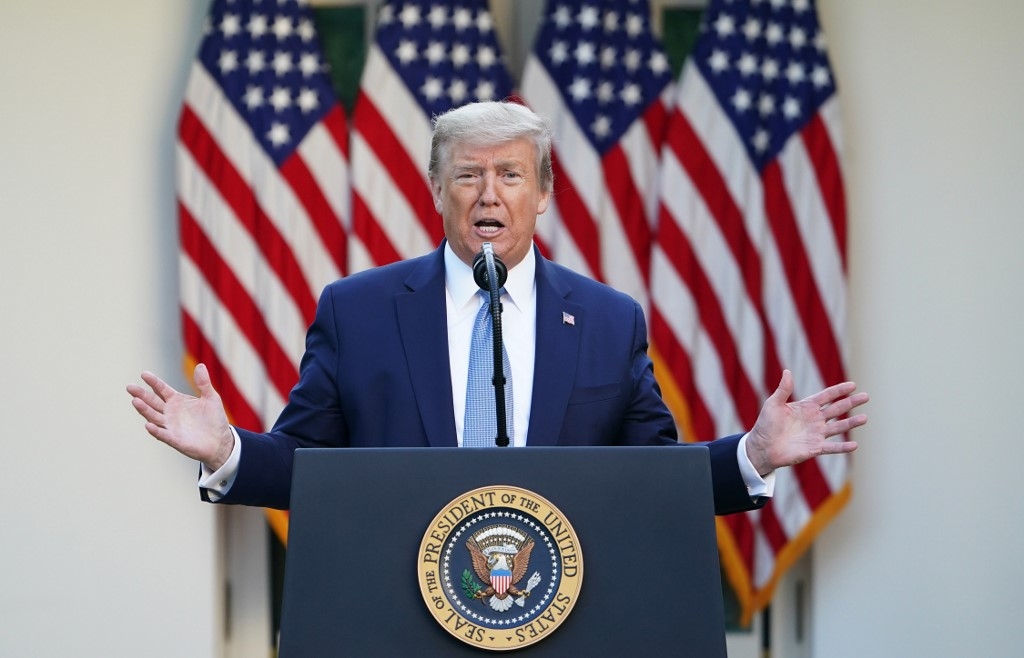
The white US liberal intelligentsia has been constantly frustrated since the election of President Donald Trump in 2016.
The more attacks the white and corporate-controlled liberal US media outlets launch against the business-supported Trump, the more popular he becomes.
As white liberals feign concern over Trump’s continued dismantlement of the welfare state and restoration of an unapologetic white supremacist system, his many supporters celebrate these achievements and demand more.
What is it that makes Trump so much more persuasive to so many Americans than the liberal media and its pundits?
Uniting against the communist threat
To comprehend how US political culture understands the welfare state and the dismantlement of institutional white supremacy, we must go back and understand how they came about in the first place.
When amid the Great Depression, then US President Franklin Roosevelt opted for the New Deal to transform the country into a welfare state beginning in the 1930s (expanded by his successors through the 1960s), he did so to save US capitalism from the impending communist threat while maintaining white supremacy, and not because of any socialist leanings.
US liberal journalism, mortgaged to big corporations and their crusade against communism, celebrated these transformations
The Russian Revolution was institutionalising itself by the mid-1920s as an example for the world to follow, and by the 1930s the US Communist Party's influence on American workers became a veritable threat to the capitalist order.
Indeed, with the major triumph of the Soviet Union over Nazi Germany, the threat of communism had become so great by the end of WWII that the white capitalist powers opted to stop their competition and unite against the communist threat.
Anti-Soviet propaganda began in earnest after the war, as the Americans launched a religious war against the Soviets, condemning them as secular and Godless atheists. Former President Dwight Eisenhower decided to get baptised in office and brought the fanatical reverend Billy Graham in as a spiritual adviser to the White House.
Eisenhower began the tradition of the “National Prayer Breakfast” and started his cabinet meetings with a moment of silent prayer. The Pledge of Allegiance was transformed in 1954 by Eisenhower from “I pledge allegiance to the flag of the United States of America and to the republic for which it stands, one nation, indivisible, with liberty and justice for all”, to pledging allegiance to one nation “under God”.
In 1956, Congress enacted a law signed by Eisenhower that introduced the phrase “In God We Trust” to be printed on American paper currency, replacing the erstwhile phrase “E pluribus unum” (out of many, one), in use since 1776.
Two years later, Congress enacted a law introducing the phrase “In God We Trust” as the national motto of the US.
Institutional white supremacy
US liberal journalism, mortgaged to big corporations and their crusade against communism, celebrated these transformations. It was the Eisenhower administration that enlisted religion and invented anti-communist Islamist jihadism as a weapon against Soviet communism and Third World socialism, with Saudi Arabia subcontracted for the role soon after.
As a result of Eisenhower’s Protestant Christian institutionalisation, the proportion of religious Americans rose from 49 percent in 1940 to 69 percent in 1960.
These transformations took place when the US South was run by a white supremacist, racial segregationist system, while racist institutions and structures dominated the north and the federal government.
Federal laws created white-only towns called “the suburbs”, enforced by racially restrictive “covenants” for home ownership, while the 1944 GI bill made benefits in housing and education available only to white people.
In the context of an institutionally white supremacist US, American journalists and intellectuals sang the glories of US democracy against Godless communism.
But if the welfare state was able to pull the rug out from under the communists, white supremacy made the US vulnerable to anti-racists, communist or otherwise, around the world. This was especially grave for US imperialism, as recently decolonised countries around the world, who had just rid themselves of the European colonial racist yoke, looked to the Soviets as an anti-racist, socialist example with which to ally, rather than the white supremacist US.
Just as the welfare state put a human face on capitalism, there was a need for a human face to be placed on US white supremacy. The 1954 Supreme Court case of Brown v Board of Education began the dismantling of the racist apartheid educational system. This was mainly done not as a concession to African Americans, but as part of the imperialist strategy to attract Third World countries repulsed by US white supremacy.
Emboldening the new right
But the momentum of the black struggle to end white supremacy within the US could not be stopped, and it proceeded apace in the 1960s, with increasing white liberal concessions from the state and its judicial system - especially as the dismantlement of formal white supremacist structures seemed to beautify the ugly reality of US white supremacy.
US liberal journalism and the liberal white intelligentsia again celebrated the state’s achievements - while simultaneously targeting black “radical” civil libertarians with racist propaganda campaigns - as proof of the glories of US democracy against “totalitarian” communism.
This, however, did not appeal to the massive white racist political culture, especially as racist depictions of non-whites in US culture continued on liberal white-dominated television screens and in the culture at large.
Horrified by these concessions that weakened formal white supremacy, the new right, emboldened by white liberal anti-communism, racism, and Eisenhower’s institutionalised religion, began to organise in the late 1960s, demanding the reinstatement of white supremacy and the dismantling of the welfare state.
The New Jim Crow system was instituted in the 1970s and has intensified since the 1980s to keep African Americans “in their place”, while former President Ronald Reagan and his successors heeded corporate demands to get rid of the Soviets once and for all so that the New Deal could be safely dismantled.
Once the Soviets were gone, presidents Bill Clinton and Barack Obama intensified the destruction of the welfare state, while putting a lovable human face on US neoliberalism and white supremacy. This is why Obama, especially, was and remains the best thing that ever happened to white liberals.
Racial tokenism
With the fall of the communist threat, the liberal discourse of US democracy deployed since the 1960s lost its efficacy. Liberal notions of “multiculturalism” and “diversity”, which had not improved the lives of the majority of blacks, Latinos or Native Americans, whose poverty and oppression persist, as is the case with poor whites (and the majority of the poor in the US are indeed white), were quickly understood as neoliberal and liberal ruses of white supremacist racial tokenism.
The liberal US corporate media never laid blame for the poverty of Americans on the white owners of big business, having itself been part of the white supremacist corporate attacks on the welfare state since the 1970s as a system of privilege for “lazy” non-white Americans at the expense of “hard-working” white Americans.
As a result, the majority of the white poor became ingrained with the idea that their real and only identity was white, not poor, and that their enemy was not the white owners of the corporations that impoverished them, but the victimised poor non-whites and immigrants.
When Trump arrived on the scene, he did not tell poor white Americans anything that they had not been taught by US culture, media, and evangelical Protestantism
When Trump arrived on the scene, he did not tell poor white Americans anything that they had not been taught by US culture, media, and evangelical Protestantism since Billy Graham.
Trump’s strategy, like that of the white supremacist right of which he is a part, was to tell the white poor that as white people, he was on their side, and that their enemy was not only what remains of the US welfare state, but also (the pretend) US “multicultural democracy” that white liberalism has used to cover up US white supremacy since the 1970s.
Yet what Trump promises poor white Americans who lack white and class privilege - and whom white liberals, such as Hillary Clinton, find “deplorable” - is a restoration of formal white supremacy, which they mistake for an amelioration of their poverty.
Corporate aspirations
As there is no longer a communist threat, and Third World neoliberal elites have been converted since the 1970s into the biggest fans of the US (now that they can be inducted into the one percent through “diversity” and “multiculturalism” programmes), conservative US white supremacists correctly realised that they could come out of the closet and demand the reversal of all the concessions the liberal white supremacists had instituted during the communist threat years.
Trump represents these corporate aspirations, which have been pushed by the US liberal media and culture for decades. Indeed, Trump is a creation of white American liberalism’s own trajectory, not a contradiction to it.
This is why when hypocritical US liberal journalists and pundits question Trump during press conferences - most evident during the recent coronavirus crisis - or debate his appeal on liberal television networks, he shows them up easily for the hypocrites they are.
What accounts for this achievement is Trump’s sincere commitment to the restoration of an unabashed, unapologetic US white supremacy and runaway capitalism that easily withstands the wishy-washiness of white US liberalism and its continued commitment to white supremacy with a human face, whether a white one or in blackface.
The views expressed in this article belong to the author and do not necessarily reflect the editorial policy of Middle East Eye.
Middle East Eye propose une couverture et une analyse indépendantes et incomparables du Moyen-Orient, de l’Afrique du Nord et d’autres régions du monde. Pour en savoir plus sur la reprise de ce contenu et les frais qui s’appliquent, veuillez remplir ce formulaire [en anglais]. Pour en savoir plus sur MEE, cliquez ici [en anglais].



